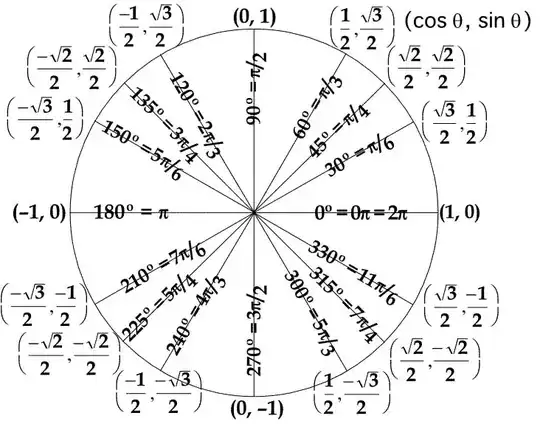$$\sum_{k=1}^{\infty} \frac{1}{6}(-\frac{1}{2})^{k} = \frac{1}{9}\\$$
The basic unit circle goes all the way up to integral multiples of $\frac{\pi}{6}$; thus, it is reasonable to assume that $\sin{\frac{\pi}{9}}$ can reasonably be written as an infinite nested root through half-angle formulas. The resulting numerators of the above stated geometric sequence follow the pattern such that, assuming $a_{0}$ is 1, and ${k}$ follows suit with ${n}$:
\begin{align*}
a_{n+1} = 2a_{n}-1 \ \ \textrm{if} \ \ {n}\mod{2} = 0\\
a_{n+1} = 2a_{n}+1 \ \ \textrm{if} \ \ {n}\mod{2} = 1
\end{align*}
Because of this, every third term ($a_{2},a_{5},...$) can be simplified, and thus have a slightly different final nested root.
Starting the half-angle chains using the sums produced from the equation above, it looks something like this:
\begin{gather*}
\sin{\frac{\pi}{6}}=\frac{1}{2}\\
\sin({\frac{\pi}{6}-\frac{\pi}{12}})=\sin{\frac{\pi}{12}}=\sqrt{\frac{1-\cos{\frac{\pi}{6}}}{2}}=\frac{\sqrt{2-\sqrt{3}}}{2}\\
\sin({\frac{\pi}{6}-\frac{\pi}{12}+\frac{\pi}{24}})=\sin{\frac{3\pi}{24}}=\sqrt{\frac{1-\sqrt{\frac{1+\cos{\frac{3\pi}{6}}}{2}}}{2}}=\frac{\sqrt{2-\sqrt{2}}}{2}\\
\sin({\frac{\pi}{6}-\frac{\pi}{12}+\frac{\pi}{24}-\frac{\pi}{48}})=\sin{\frac{5\pi}{48}}=\sqrt{\frac{1-\sqrt{\frac{1+\sqrt{\frac{1+\cos{\frac{5\pi}{6}}}{2}}}{2}}}{2}}=\frac{\sqrt{2-\sqrt{2+\sqrt{2-\sqrt{3}}}}}{2}\\
\end{gather*}
$\frac{3\pi}{24}$ is left as is to visibly see the divisibility of the fraction, and the correlation with both the terms before and after it regarding the nested roots. Every 3 terms after this can also be simplified; thus, after the following terms of the sequence, things will start to repeat...
$$\sin({\frac{\pi}{6}-\frac{\pi}{12}+\frac{\pi}{24}-\frac{\pi}{48}+\frac{\pi}{96}})=\sin{\frac{11\pi}{96}}=\sqrt{\frac{1-\sqrt{\frac{1+\sqrt{\frac{1+\sqrt{\frac{1+\cos{\frac{11\pi}{6}}}{2}}}{2}}}{2}}}{2}}=\frac{\sqrt{2-\sqrt{2+\sqrt{2-\sqrt{2+\sqrt{3}}}}}}{2}$$
After this term follows another value, $\frac{21\pi}{192}$, which can be simplified. Just like its predecessor, its final nested root is $\sqrt{2}$, which is then further nested similarly to the last occurrence. Since this is a recurring pattern, the value of $\sin{\frac{\pi}{9}}$ is thus defined to be
$$\frac{\sqrt{2-\Big[{\sqrt{2+{\sqrt{2-{\sqrt{2+...}}}}}}\Big]}}{2}$$
where the bracketed expression is self-recursive (that is, the expression fills in the ellipsis and leaves another ellipsis to be filled again). This value is approximately equal to $0.34202014333$.
